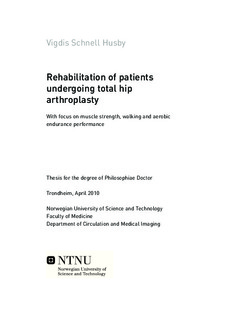| dc.contributor.author | Husby, Vigdis Schnell | nb_NO |
| dc.date.accessioned | 2014-12-19T14:23:39Z | |
| dc.date.available | 2014-12-19T14:23:39Z | |
| dc.date.created | 2010-12-06 | nb_NO |
| dc.date.issued | 2010 | nb_NO |
| dc.identifier | 374862 | nb_NO |
| dc.identifier.isbn | 978-82-471-2023-1 (printed ver.) | nb_NO |
| dc.identifier.uri | http://hdl.handle.net/11250/264716 | |
| dc.description.abstract | Patients having completed rehabilitation after undergoing THA demonstrate a 40 % reduced muscle strength, 26 % lower maximal oxygen consumption (VO2max), 42 % reduced work efficiency and an asymmetric loading of the limbs 3-5 years after completed rehabilitation when compared to healthy age-matched subjects. The reduced VO2max in THA patients implies increased risk for co-morbidity. The results indicate that the current rehabilitation programs are inefficient in restoring muscle strength and aerobic endurance performance in THA patients.
Unilaterally and bilaterally operated THA patients demonstrate similar outcome in VO2max, work efficiency and gait patterns. A bilaterally operated group with normal medial femoral head offset (FO) in the hip joint was compared with a bilaterally operated group with FO < 5mm of preoperative values. No differences in hip abductor muscle strength, VO2max, work efficiency or gait patterns were found between the bilaterally operated groups.
Maximal strength training with few repetitions, heavy loads and maximal concentric contraction is an efficient and safe treatment in the early postoperative phase for patients undergoing THA. Maximal strength training improved rate of force development (RFD) by 65%, hip abduction by 87 % and leg press by 65 % in the operated leg compared to conventional rehabilitation. The results of 4 weeks maximal strength training starting 1 week postoperatively compared with conventional rehabilitation programme, equalise those of THA patients operated 3-5 years ago.
6-12 months after THA, the early maximal strength training intervention resulted in improved work efficiency by 29 and 30 %, respectively and an increase in RFD by 74 % after 12months compared with the conventional rehabilitation programme. Work efficiency and RFD are important functional parameters as the oxygen needed to perform a specific task is reduced and the risk for falling has shown to be lower with improved RFD. | nb_NO |
| dc.language | eng | nb_NO |
| dc.publisher | Norges teknisk-naturvitenskapelige universitet, Det medisinske fakultet, Institutt for sirkulasjon og bildediagnostikk | nb_NO |
| dc.relation.ispartofseries | Doktoravhandlinger ved NTNU, 1503-8181; 2010:34 | nb_NO |
| dc.relation.ispartofseries | Dissertations at the Faculty of Medicine, 0805-7680; 430 | nb_NO |
| dc.relation.haspart | VS, Husby; Helgerud, J; Bjørgen, S; Husby, OS; Benum, P; Hoff, J. Reduced strength, work efficiency and maximal oxygen consumption 3-5 years after total hip arthroplasty. . | nb_NO |
| dc.relation.haspart | Husby, Vigdis S; Bjørgen, Siri; Hoff, Jan; Helgerud, Jan; Benum, Pål; Husby, Otto S. Unilateral vs. bilateral total hip arthroplasty - the influence of medial femoral head offset and effects on strength and aerobic endurance capacity.. Hip international : the journal of clinical and experimental research on hip pathology and therapy. (ISSN 1724-6067). 20(2): 204-14, 2010. <a href='http://www.ncbi.nlm.nih.gov/pubmed/20544648'>20544648</a>. | nb_NO |
| dc.relation.haspart | Husby, Vigdis S; Helgerud, Jan; Bjørgen, Siri; Husby, Otto S; Benum, Pål; Hoff, Jan. Early maximal strength training is an efficient treatment for patients operated with total hip arthroplasty.. Archives of Physical Medicine and Rehabilitation. (ISSN 0003-9993). 90(10): 1658-67, 2009. <a href='http://dx.doi.org/10.1016/j.apmr.2009.04.018'>10.1016/j.apmr.2009.04.018</a>. <a href='http://www.ncbi.nlm.nih.gov/pubmed/19801053'>19801053</a>. | nb_NO |
| dc.relation.haspart | Husby, Vigdis Schnell; Helgerud, Jan; Bjørgen, Siri; Husby, Otto Schnell; Benum, Pål; Hoff, Jan. Early postoperative maximal strength training improves work efficiency 6-12 months after osteoarthritis-induced total hip arthroplasty in patients younger than 60 years.. American Journal of Physical Medicine & Rehabilitation. (ISSN 0894-9115). 89(4): 304-14, 2010. <a href='http://dx.doi.org/10.1097/PHM.0b013e3181cf5623'>10.1097/PHM.0b013e3181cf5623</a>. <a href='http://www.ncbi.nlm.nih.gov/pubmed/20134307'>20134307</a>. | nb_NO |
| dc.title | Rehabilitation of patients undergoing total hip arthroplasty | nb_NO |
| dc.type | Doctoral thesis | nb_NO |
| dc.contributor.department | Norges teknisk-naturvitenskapelige universitet, Det medisinske fakultet, Institutt for sirkulasjon og bildediagnostikk | nb_NO |

